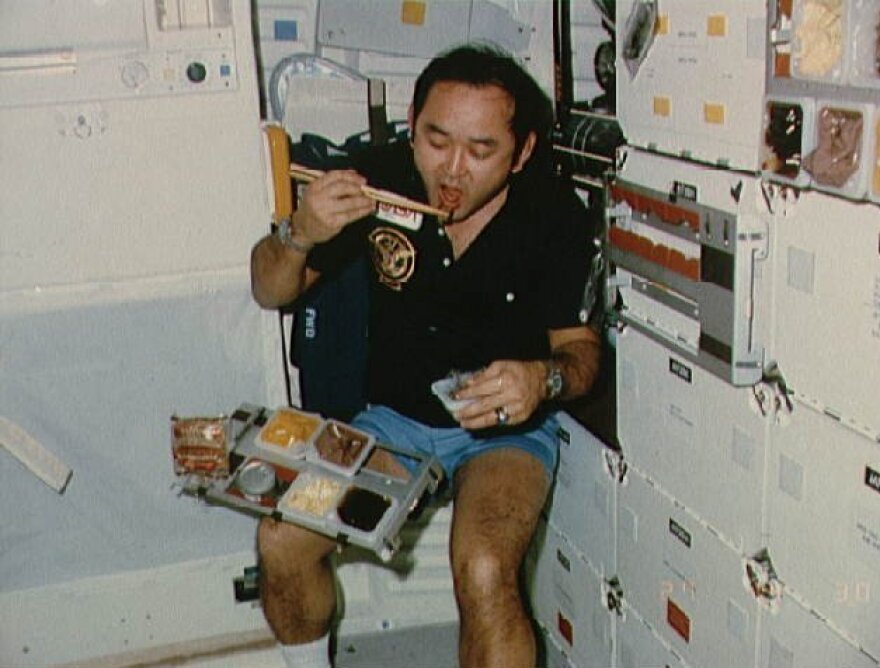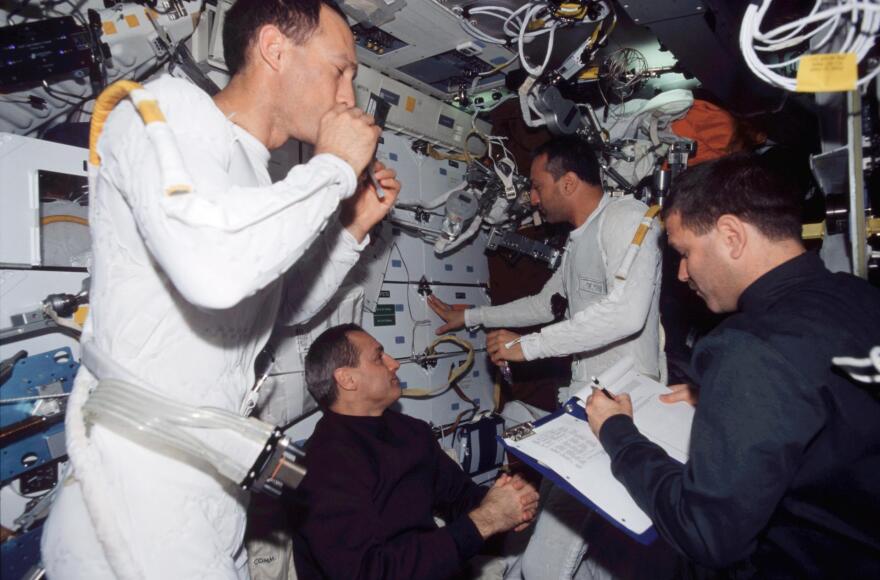The Apollo program was gigantic.
The U.S. government spent roughly $26 billion (about $260 billion in today's dollars, according to one estimate) between 1960 and 1972 to hire contractors and subcontractors who employed hundreds of thousands of people to create and improve on technology that led us to the moon and back.
While some of that tech has stayed within the space industry, a lot of it has trickled down to the public. There's a huge list of the stuff. NASA has an entire department dedicated to cataloging it all.
Sometimes separating myth from reality isn't easy. These six, however, are bona fide space program spinoffs.
Freeze-dried food
Beef pot roast, lobster bisque, peach ambrosia – all things that, if you were an Apollo astronaut, you might be eating out of a plastic pouch while speeding away from Earth at 5,000 miles per hour.
Freeze-dried foods were perfect for the weight-conscious Apollo missions, in which the spacecraft needed to stay lean enough to get to the moon and back even as the astronauts consumed a hearty 2,800 calories per day to keep themselves going.
A favorite? Shrimp cocktails, according to Charles Bourland, a food scientist who started working on the Apollo program in 1969.
"It's got a little bit of spice to it, and shrimp hydrates really well. It's just like having a fresh shrimp with cocktail sauce," he says.
One thing they had to avoid? High-fiber diets.

On the Apollo missions, the system for defecation was little more than a bag with a small opening and some adhesive around the edge. It was so inconvenient that it could take astronauts 45 minutes to complete the process and there was a chance that the, um, waste material could escape and soil other parts of the cabin.
"Astronauts didn't want to have to go to the bathroom any more than they had to," Bourland says. "I always said the bathrooms in the spacecraft were the biggest improvement in the food system."
Since Apollo, space toilets have gotten better and "we could start using regular food," he says.
Freeze-dried foods weren't invented for Apollo specifically, but the number of varieties, their texture, flavor and presentation all changed because of it. Fruit cocktails, for instance, had to be reformulated so that they wouldn't be crushed when sealed in vacuum bags.
(Sorry to disappoint, but astronaut ice cream wasn't part of the space program.)

Cooling suits
Spacesuits need to be completely sealed to protect astronauts from the ravages of the great unknown, which also means that they can get pretty stuffy.
That's why NASA acquired rights to use liquid cooling and ventilation garments in 1966. The skintight suits had 300 feet of tubing snaking along the outside and running chilled water across the skin, pulling heat away from the astronaut's body and helping them control their core temperature.
Fifty-three years after the design was made public, it's being used to help people with multiple sclerosis whose symptoms are exacerbated by heat.
"Heat for me is like kryptonite for Superman," says Josie Benassi from Reading, Mass., who has multiple sclerosis and likes to go on long tandem bike rides with her husband.
When temperatures rise above 75 degrees, her muscles weaken and it can be tough for her to walk or even stand. A cooling vest, attached to a cooler with a pump and a battery pack makes those rides possible.
"Without cooling gear, I'm good outside for 20 minutes," says Marco Martinez, from Austin, Texas, who also has MS. "I'm a prisoner from June until September in the house unless I have some cooling equipment with me."
The product Marco and Josie use is from CoolShirt Systems, whose founder was inspired by NASA's design.
Fireproof materials
After three astronauts were killed in the Apollo 1 fire on Jan. 27, 1967, NASA was left scrambling to try to figure out how to make everything in the command module less flammable, including what the astronauts were wearing.
The agency needed something that wouldn't melt or catch on fire and that could insulate astronauts from the intense heat of flames.
It found what was needed in polybenzimidazole, or PBI, a heat-resistant material developed by Dr. Carl Shipp Marvel (yes, "Dr. Marvel"), a pioneer in synthetic materials. After Apollo 1, the Celanese Corporation came up with a fiber that was woven into clothing beneath the puffy outer shell of the astronauts' spacesuits, providing another layer of protection, although it has since been phased out.
Firefighting suits that contain PBI are one main market for the material now. According to the manufacturer, it's effective for up to 1300 degrees.
"A lot of people don't realize that's where [it] came from. It started from Apollo," says Bill Lawson, president of PBI Performance Products, which was spun off by Celanese and sold to investors in 2005. "Unfortunately, those three astronauts paid the ultimate price, but yet no one would've probably made PBI unless that happened."
Spring tires
Driving on the moon is way more extreme than off-roading on Earth. Wild temperature swings and unfiltered sunlight will punish regular tires. Shards of dried lava will shred them. And there's six times less gravity, so if you hit a rock, it'll send you flying.
What you need is a durable tire – stiff enough to support a vehicle, but squishy enough to roll right over rocks. Oh, and you can't have a flat. (AAA won't come to get you.)
So Apollo engineers outfitted the Lunar Roving Vehicle with airless tires made of springy, woven steel wire that were much like guitar or piano string. Those tires were on rovers that flew with Apollo 15, 16 and 17. Then they were forgotten for more than 30 years.
But in 2004, President George W. Bush declared we were returning to the moon. As NASA got in gear, Vivake Asnani, a young aerospace technologist at NASA's Glenn Research Center, became fascinated by the long-forgotten wheels.
"It was totally amazing that they came up with this. How do you think of something like this?"

In 2007, Asnani tracked down the original designers, one of whom pulled a spare Apollo tire out of his closet as a gift. With Goodyear's help, Asnani's team built a dozen replicas. By 2009, they had developed an even better version with a chain-mail-like appearance, which they called the "spring tire." They were ready for the moon. And then, President Barack Obama canceled the program.
Since then, Asnani's team has swapped steel wire for a nickel titanium "shape memory alloy," a better material with the superpower to deform and regain its shape. They've tested the tires on Jeeps, and Asnani says the idea could be used to make Earth tires that never go flat.
Oh, and now that our sights are once again on the moon? Chances are we'll want wheels when we get there.

Digital fly-by-wire
Neil Armstrong was an outstanding pilot, who had "the right stuff" to get NASA to the moon. But even a pilot of his caliber couldn't single-handedly control the lunar module's 16 thrusters and two rocket engines.
"The job of flying a spacecraft is too mathematical for a human to do it by the seat of their pants, so there really is a necessity to have a computer," says Don Eyles, a computer scientist who worked on software for the Apollo lunar module.
The Apollo spacecraft was a crucial demonstration of digital fly-by-wire technology. Instead of a manual system of pulleys, cables and hydraulics attached to the pilot's control stick and pedals, in a digital fly-by-wire system, the pilot's controls feed into a computer, which uses software to process and translate those commands into electrical signals sent to the components that control the spacecraft's movement.
"It really created a kind of digital reality," says David Mindell, CEO of Humatics and author of Digital Apollo. "The human is flying an idealized model of the machine, which is a simulation. And then the computer control forces the machine to behave like that idealized model."
Digital fly-by-wire technology has since helped steer the space shuttle, commercial jets such as the Boeing 777 and the Airbus 320, and a fleet of fighter jets and bombers. In fact, it was the F-8 Crusader jet that first used the technology ... after NASA engineers proposed installing an analog fly-by-wire system in the plane in 1970.
The deputy associate administrator for aeronautics at NASA reportedly asked, "Why analog?" The engineers replied that they knew of no digital computer qualified for flight. The administrator, who happened to be Armstrong himself, replied: "I just went to the moon and back on one."

Integrated circuits
The Apollo spacecraft required light, compact, powerful computers. So NASA and the MIT Instrumentation Lab made a daring decision. They built the Apollo Guidance Computer with a promising but relatively unproven technology: the integrated circuit, which packed multiple transistors onto a single silicon "chip."
The Apollo program didn't invent the microchip, but it guaranteed a huge early market – by 1963, Project Apollo absorbed up to 60 percent of the U.S. supply of chips. The military also installed chips in its Minuteman-II missiles.
Both NASA and the Air Force forced companies like Fairchild Semiconductor to prove the chips' reliability by subjecting them to extreme temperatures and G-forces and rigorous visual and electrical inspections. The result? Apollo helped in part to accelerate the silicon chip revolution, at the pace predicted by Gordon Moore's famous law about the accelerating pace of computing power.
"You probably still would have had integrated circuits," says John Tylko, a scholar who teaches a course called Engineering Apollo at MIT. "You probably still would have had Moore's Law. But you might not have had Moore's Law in 1965. You might have had it a decade later."
Tylko says that astronaut Eugene Cernan, who left humankind's last footprints to date on the moon, may have summed up Apollo's achievements best in 2007 when he said: "It's almost as if [President John F. Kennedy] reached out into the 21st century where we are today, grabbed hold of a decade of time, slipped it neatly into the '60s and '70s and called it Apollo."
Christopher Intagliata is a senior producer and editor for the public radio show Science Friday and a reporter for Scientific American's 60-Second Science podcast. Jacob Margolis is a science reporter at KPCC and the host of the earthquake podcast The Big One: Your Survival Guide.
Copyright 2023 NPR. To see more, visit https://www.npr.org.




